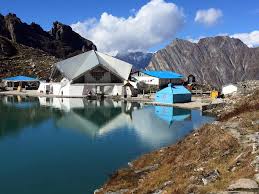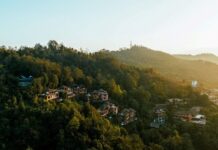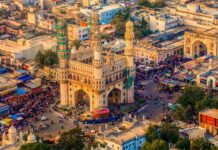 Hemkund Sahib (also spelled Hemkunt), known as Gurudwara Sri Hemkund Sahib Ji, is a Sikh place of worship and pilgrimage site in Chamoli district, Uttarakhand, India. It is devoted to Guru Gobind Singh Ji (1666–1708), the tenth Sikh Guru, and finds mention in Dasam Granth, a work dictated by Guruji himself.
Hemkund Sahib (also spelled Hemkunt), known as Gurudwara Sri Hemkund Sahib Ji, is a Sikh place of worship and pilgrimage site in Chamoli district, Uttarakhand, India. It is devoted to Guru Gobind Singh Ji (1666–1708), the tenth Sikh Guru, and finds mention in Dasam Granth, a work dictated by Guruji himself.
A Hindu shrine dedicated to mythological hero Lakshmana is an attraction for Hindu pilgrims. This temple is built on the banks of Hemkund.
The picturesque natural settings make this hill region an amazing place for rejuvenating vacations. One can reach this majestic lake through a challenging but interesting and enjoyable trek from Ghangharia.
Hemkund Sahib is nestled amidst seven snow capped peaks and marvelous snowy glaciers. The nature is reflected here with all its mighty appearance in the crystal clear alluring water. Hemkund Lake is fed by the glaciers from majestic peaks known as Hathi Parvat and Saptrishi peaks. A small stream known as Himganga originates from this imposing lake.
With its setting of a glacial lake surrounded by seven mountain peaks, each adorned by a Nishan Sahib on its cliff, it is according to the Survey of India located in the Himalayas at an elevation of 4,632 meters (15,197 feet). It is approached from Gobindghat on the Rishikesh-Badrinath highway. The main town near Gobindghat is Joshimath.
Hemkund is a Sanskrit name derived from Hem (“Snow”) and Kund (“bowl”).Dasam Granth says this is the place where Pandu Raja practiced Yoga.
It is recorded in the holy Granth Sahib that the tenth Guru of Sikhs, Guru Gobind Singh meditated on the serene banks of Hemkund in one of his earlier births. In addition, the Dasam Granth says God ordered Sikh Guru Gobind Singh to take birth while he was in deep meditation at the mount of Hemkund.
Guru Gobind Singh is believed to be the Guru who founded all present characteristics of present Sikhism. The Gurudwara of the Sikhs on the banks of Hemkund is located at the place where Guru had meditated. Huge flocks of Sikh pilgrims pay their visit to this Gurudwara every year.
Inaccessible
Hemkund is inaccessible from October through April because of snow bound paths and glaciers. Sikh pilgrims arrive in May and set to work to repair the damage to the path over the winter, which tradition is called kar seva (“work service”), a concept which forms an important tenet of the Sikh faith.
The take-off point for Hemkund Sahib is the town of Govindghat about 275 kilometers (171 mi) from Rishikesh. The 13 kilometers (8.1 mi) trek is along a reasonably well maintained path to the village of Ghangaria (also called Govinddham). This path can be covered either by walk or by pony and a Gurudwara here gives shelter to pilgrims. In addition there are a few hotels and a camp ground with tents and mattresses. A 1,100-metre (3,600 ft) climb on a 6-kilometre (3.7 mi) of stone paved path leads Hemkund. Overnight stay is not allowed at Hemkund Sahib and so it is necessary to leave by 2 PM to make it back to Govindghat by nightfall.
A recent study examining altitude sickness at Hemkund Sahib found that almost one-third of pilgrims who traveled to Hemkund suffered from Acute Mountain Sickness (a form of altitude sickness). As approximately 150,000 pilgrims are believed to travel to Hemkund Sahib each trekking season, almost 50,000 people are at risk of developing Acute Mountain Sickness each year. The authors stated the difficult nature of the trek, limited water consumption and lack of awareness regarding altitude sickness as the main contributory factors.
Design and construction of the present gurudwara was started in the mid-1960s, after Major General Harkirat Singh, Engineer-in-Chief, Indian Army visited the gurudwara. Major General Harkirat Singh selected Architect Siali to head the design and construction effort. Thereafter, Architect Siali Luddu made annual trips to Hemkund Sahib and organized and supervised complex construction.
Hemkund has got mentions in the Ramayana. It is believed that the younger brother of Lord Rama, Lakshmana regained his health by meditating on the banks of Hemkund after the severe injuries he received from Meghnath during Rama-Ravana war. The Lakshmana temple is built at the place where Lakshmana meditated to regain his health.
How to reach
By Train: The nearest rail head is at Rishikesh, around 300 km from Hemkund Sahib and is well connected to other parts of the country.
By Air: The nearest airport is Jolly Grant, around 300 km from Hemkund Sahib. Jolly Grant airport is connected to Delhi and a few other cities in the country. Recently, an Indian airline company has started a helicopter service between Govindghat and Ghangria. The flight takes about 5 minutes.
By Bus: Buses are commonly available from Delhi and parts of Himachal Pradesh but the roads are connected only up to Govindghat, which is around 19 km from Hemkund. From here tourists have to undertake strenuous trek on steely slopes to reach the place.






